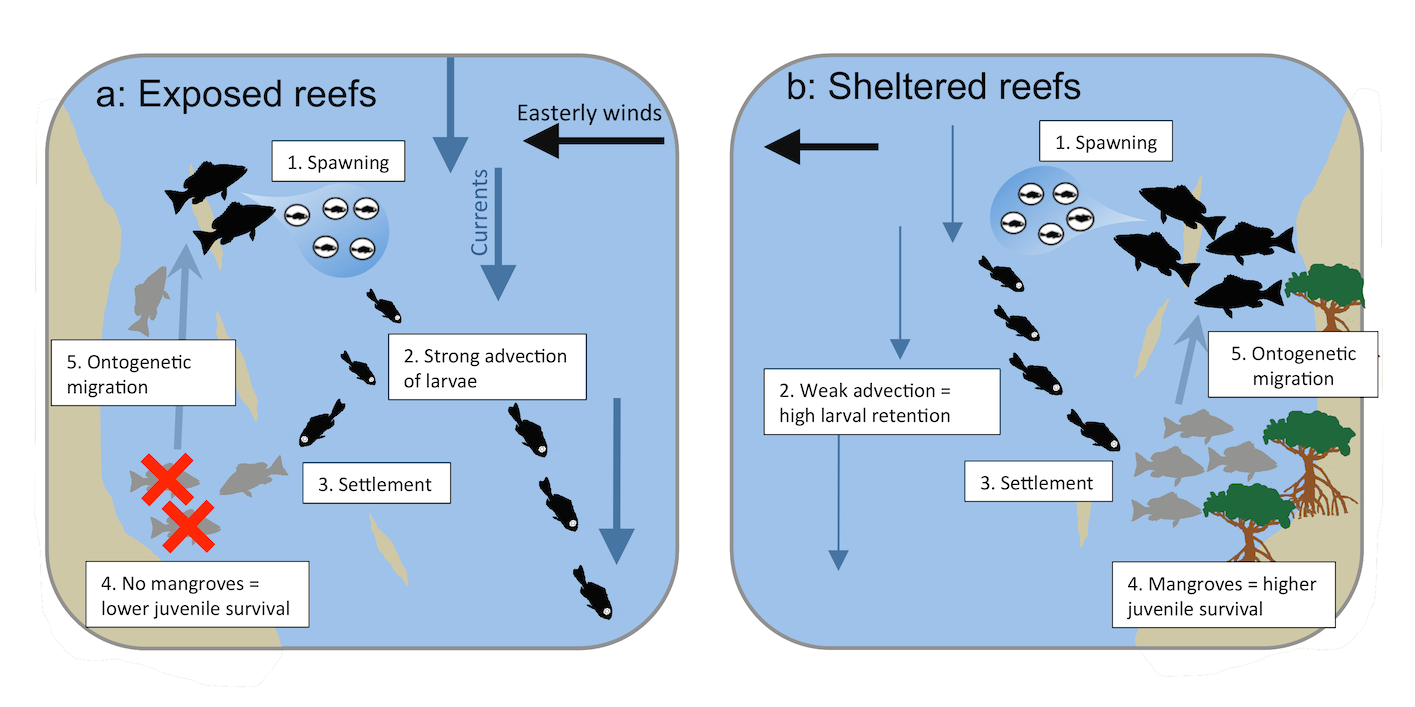Wind predicts connectivity for coral reef fish
Connectivity of organisms among habitats is fundamental to population dynamics, the evolution of species and their conservation. Two paradigms of connectivity dominate marine science. The first is the movement of larvae from their natal sites to their settlement sites. The second is the movement of fish from juvenile habitats, like mangroves, to adult habitats, like coral reefs.
In a new paper published in the journal Ecology, we show that sheltered conditions have both high larval and habitat connectivity and we subsequently predict a synergistic increase in fish biomass in sheltered environments.

We hypothesized that larval retention would be lower on more exposed coasts, because of wind-driven advection. Exposed coasts also will have lower reef to mangrove connectivity, because mangroves prefer sheltered conditions. Under sheltered conditions, connectivity to mangroves and of larvae was hypothesized to be greater, leading to a synergistic increase in adult fish biomass on reefs. Image from our paper
Rarely have these two paradigms been linked. However, linkages among them could be important. For instance, we should see higher abundances of adult fish in locations where ocean currents facilitate arrival of larvae to their favourite juvenile habitats. Such places may offer double the benefits to larvae and may be especially productive locations for fisheries, or key spawning sites to reserve in protected areas.
We asked if the high larval connectivity in terms of larvae returning to their natal site, was correlated with high connectivity among juvenile and adult habitats. To study larval and habitat linkages, we used data and comprehensive larval modelling from The Bahamas.
We found for three different fish species that the reef sites with higher retention of larvae were also more likely to have connected coral reefs and mangroves. The fish species larvae spend different amounts of time in the open ocean, suggesting the relationship is general across many species.
It turned out that exposure to wind and waves explained both high retention and connectivity among coral reefs and mangroves. The explanation is simple - mangroves like sheltered conditions so coral reefs are typically only close to mangroves in sheltered locations. Fish larvae are carried by ocean currents, so if there are high wind and waves they are more likely to be carried away. In sheltered conditions, the larvae hang around.
The effect of exposure on both larval and habitat connectivity is a real boon for fish populations. Our models predicted a synergistic increase in fish biomass in sheltered locations that resulted from a positive feedback loop: More larvae retained near their preferred mangroves meant more juveniles migrating to reefs where they spawned more larvae that settled in mangroves… and so on.
Of course there is much work left to do. The predicted synergistic increase in fish biomass is yet to be tested in the field. However, our approach generates quantitative relationships between exposure and fish biomass that could be tested in against field surveys.
Another caveat to consider is that connectivity may also benefit a fish’s predators.
Validating our predictions would be of great benefit to the conservation of reef fish. For instance, using one variable along - exposure - we can predict the reef sites most suited to fish and identify productivity hotspots that are likely important for natural ecosystems and fisheries.